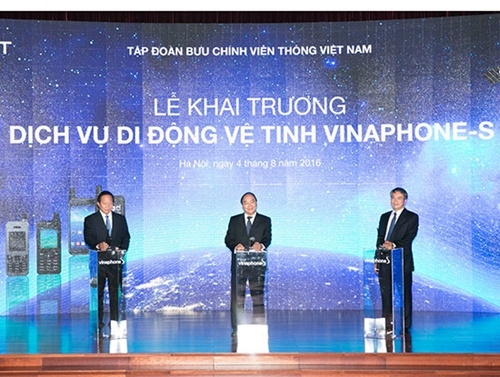 Economy
Economy

Vietnam Posts and Telecommunications Corporation (VNPT) on Thursday launched a satellite mobile service known as VinaPhone-S.
 |
| PM Nguyen Xuan Phuc (centre) and representatives of MIC and VNPT press the button to officially launch a satellite mobile service on Thursday. — Photo ictnews.vn |
HA NOI — Vietnam Posts and Telecommunications Corporation (VNPT) on Thursday launched a satellite mobile service known as VinaPhone-S.
The VinaPhone-S is a satellite mobile service covering about two-thirds globally and 100 per cent of Vietnamese territory.
With this satellite mobile service, customers using post-paid sim cards can easily implement voice services, short message service (SMS), and satellite navigation (GPS) to ensure their communication anywhere, without being dependent on telecoms infrastructure, weather, and geography.
For State agencies, VinaPhone-S will become an effective solution for forest rangers, fisheries resources surveillance and coast guards and assist people living in remote, border and island areas.
For production and business activities, VinaPhone-S will help ensure smooth communications for businesses in mining, fisheries, international transportation, and construction, apart from tourism.
For individuals, who frequently travel or work in areas without cellular network such as fishermen, oil rig workers, forest rangers, and coastal patrols, the services will be a significant tool.
According to Pham Duc Long, general director of VNPT, three quarters of Viet Nam’s land is mountains and it has about 1,000,000 sq.km of coastline under the sovereignty and jurisdiction of Viet Nam that need to ensure regular and continuous communication. Viet Nam has about two million fishermen, who are engaged in offshore fishing and they need to communicate with the mainland and their relatives.
In addition, communications also need to be well connected for organisations and businesses operating in the field of maritime transportation, mining, oil and gas, and tourism.
However, the use of GSM technology cannot meet every requirement. Thus, the current mobile technology does not allow mobile waves covering all remote and mountainous areas and sea as well. — VNS




